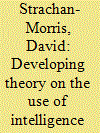| Srl | Item |
| 1 |
ID:
168616


|
|
|
|
|
| Summary/Abstract |
This special section has its origins in the observation that in the intelligence and counterinsurgency literature insurgents tend to be treated as something that intelligence acts upon but rarely, if ever, treated as intelligence actors in their own right. A review of the literature and military doctrine on counterinsurgency highlights this gap and demonstrates the importance of studies such as those brought together in this special section of Intelligence and National Security.
|
|
|
|
|
|
|
|
|
|
|
|
|
|
|
|
| 2 |
ID:
099245


|
|
|
| 3 |
ID:
113402


|
|
|
|
|
| Publication |
2012.
|
| Summary/Abstract |
Since the events of 9/11 the terms 'threat' and 'risk' have entered the daily lexicon to a greater extent than ever before. News media report on changes to national threat assessments, commenting when the threat level rises from 'Moderate' to 'Substantial', in the case of the United Kingdom. The British government recently released a document that provided details of the issues that pose the highest risk to the national infrastructure. All of these are based, so we are told, on the work of the national intelligence agencies. But what are these indicators actually telling us and what is the relationship between threat assessments and risk assessments? These are both important questions because important decisions are made as a result of changes in these assessments. National defence and security planning is based upon perceived threats and risks. An entire risk management industry has grown up in the business world that covers everything from health and safety to financial risk. It is not only governments and businesses that base decisions on these indicators, but individuals as well. Tourists planning holidays in Europe were alarmed when the British, French and German governments increased their threat levels in response to intelligence that suggested that an attack against tourist sites in their respective capitals was imminent. Some will have changed their plans and travelled elsewhere, to the detriment of the tourist industry, while others will have chosen to defy the terrorists and travel anyway - potentially placing themselves in harm's way. With so much at stake, both nationally and individually, it is therefore important that we understand the difference between a 'threat' and a 'risk' and, as scholars of intelligence, the role that intelligence plays in assessing them.
|
|
|
|
|
|
|
|
|
|
|
|
|
|
|
|
| 4 |
ID:
168617


|
|
|
|
|
| Summary/Abstract |
The need to define intelligence is understandable because the secrecy surrounding it can almost make it appear too amorphous to study. In most definitions, the authors not only attempt to define what intelligence is but also who does it. Until recently the focus has been on the state with occasional focus on sub-state actors such as law enforcement agencies. After 9/11 there was a shift from the study of inter-state intelligence to the use of intelligence against non-state actors such as Al Qaeda. The literature still treated these non-state actors as something to be acted upon rather than intelligence actors in their own right. By examining the North Vietnamese use of intelligence during the Second Indochina War this article takes a step to redress that oversight. This article will discuss the North Vietnamese use of intelligence in the context of definitions of intelligence and intelligence actors and will use John Gentry’s proposed model of violent non-state actor intelligence as its analytical framework.
|
|
|
|
|
|
|
|
|
|
|
|
|
|
|
|
| 5 |
ID:
155213


|
|
|
|
|
| Summary/Abstract |
This article uses our experience of teaching a postgraduate course in Intelligence Studies as a basis for discussion of core issues relating to contemporary intelligence education. After situating our understanding of Intelligence Studies in the context of wider debates about its nature and purpose, the article goes on to discuss key questions of how, who, and what we teach when we teach ‘intelligence’. It discusses the pedagogical benefits of a Distance Learning approach to teaching intelligence. It presents a picture of variegated demand arising from a dynamic and expanding professional sector and the continued appeal of studying the subject to non-professionals. It concludes that in providing ‘education’ rather than ‘training’ and taking a constructivist approach to learning as a shared journey, the ‘Leicester Approach’ can both improve the practice of intelligence and widen participation in key debates about intelligence.
|
|
|
|
|
|
|
|
|
|
|
|
|
|
|
|